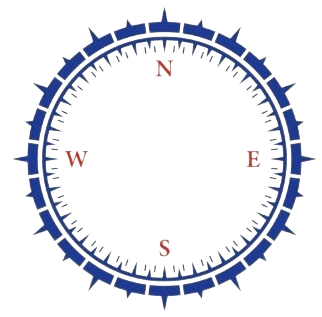Your basket is currently empty!
History of the Club
Patron HRH The Prince PHILIP, Duke of Edinburgh, KG, KT. OM. GBE.
Former Patrons:
HM Queen Adelaide 1845 to 1847.
HM Queen Victoria 1847 to 1901.
& HRH The Prince Albert The Prince Consort 1847 to 1861.
HM King George V 1911 to 1936.
(Commodore for 15 years as Duke of York and Prince of Wales 1895 to 1910.)
HM King George VI 1936 to 1952.
Annual regattas at Harwich providing racing events for both yachts and working boats had been organised since 1828 when, in 1843, a yacht club was formed to run them. The so called Eastern Yacht Club carried on for the next two years running these annual events. In 1845 its Rear Commodore, William Knight who was well connected in London through the Inns of Court, arranged for Royal Patronage, securing the Dowager Queen Adelaide (King William IV’s widow) as patron.
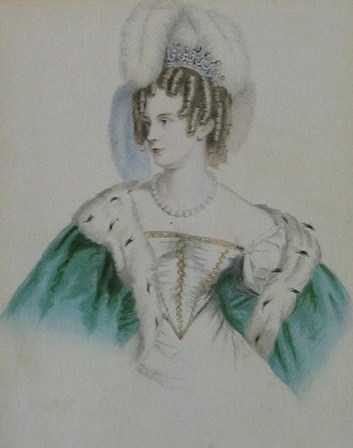
The club was renamed the Royal Harwich Yacht Club and an Admiralty Warrant was also obtained giving its sailing members significant privileges in the form of mooring rights, exemption from lightage fees and free pratique in various foreign ports. Ready-built premises existed on the seafront at Harwich in the form of the Baths and Club Room which overlooked the harbour entrance, ideal for the signalling activities which were a significant part of yacht club life at that period. With these advantageous facilities the Club quickly attracted members from both racing enthusiasts and cruising types.
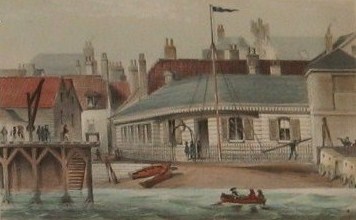
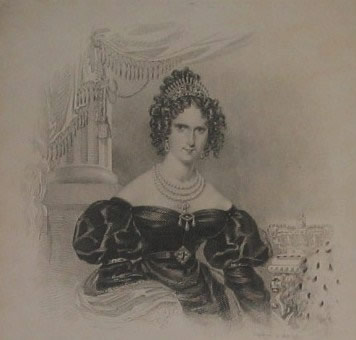
The RHYC defaced ensign with its prominent golden lion rampant was soon to be seen in many parts of the world; none more surprising, perhaps, than within the Arctic Circle. After repeated Admiralty attempts to discover the fate of Sir John Franklin’s expedition to the North West Passage, his widow commissioned a private expedition in 1857, fitting out the steam yacht “Fox”. Under the command of Captain Mclintock the “Fox” set off for the Arctic wearing Royal Harwich Yacht Club colours. The two year expedition failed to discover the exact fate of Franklin. That information had to wait for another one hundred and fifty years. However, this RHYC connection heralded further Royal Harwich involvement in Polar exploration; Captain Nares to the North in the 1880s, Prince Luigi di Savoia to the North in 1898, Scott’s first expedition to the South in 1900, and the Norwegian-British-Swedish expedition of 1949.
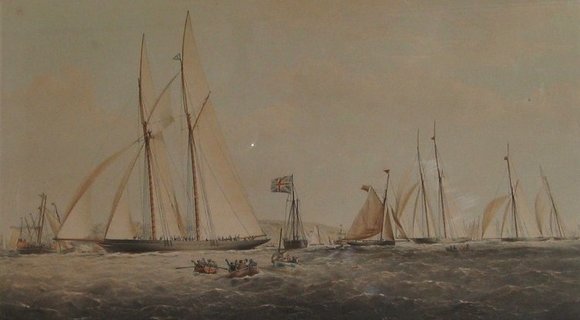
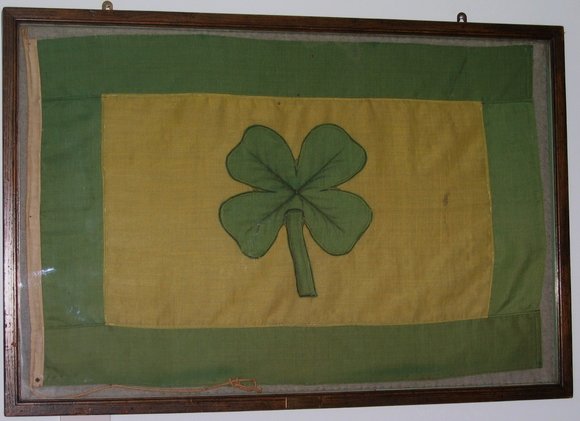
As the 19th. century progressed the Harwich regatta became increasingly popular, attracting racing yachts from the South Coast yachting centres, establishing the Royal Harwich as one of the leading racing yacht clubs in the country. This national reputation was about to go global with the appearance of James Ashbury on the racing scene. Ashbury was an ambitious racing yacht owner, fresh to the yachting scene, but established as a successful business man in the railway industry. In 1869 he enjoyed a fruitful racing season with his schooner the “Cambria”, and was appointed as Commodore of the Royal Harwich Yacht Club. His 1869 successes included a convincing win in the around the Isle of Wight against two of America’s fastest schooners.
This prompted him to challenge for the America’s Cup in 1870, the first challenge for the Cup since the “America” had lifted it as the Queen’s Cup in 1852. Although this initial challenge was through the Royal Thames Yacht Club, Ashbury raced across the Atlantic in a duel against his arch American rival, James Gordon Bennett, under Royal Harwich colours, unexpectedly winning the boat for boat match against Bennett’s larger and faster schooner, albeit by the smallest of margins.
Pitted against the entire New York Yacht Club fleet, Ashbury failed to win the Cup, but tried again in 1870 with a new schooner, the Livonia, this time challenging through the Royal Harwich Yacht Club. In a bitterly contested series of boat for boat races against a pool of defending schooners he again failed to lift the trophy despite one win and other claims of victory. Upon his return home Ashbury bombarded the NYYC with some extremely volatile correspondence creating a unfortunate precedent for many subsequent America’s Cup challenges. The Royal Harwich Yacht Club was more happily involved in the America’s Cup in 1920 when their Vice Commodore, Sir William Burton, helmed Lipton’s fourth “Shamrock”, coming within one race of winning the famous trophy.
By the end of the 19th. century the Harwich Regattas had become the opening event for each season’s Big Yacht Class attracting most of the famous racing yachts of the time, including the “Britannia” owned by the Prince of Wales (later King Edward VII). His son, George Duke of York, also a keen and knowledgeable yachtsman, was appointed as Commodore of the Royal Harwich Yacht Club in 1895. He continued in this post as Prince of Wales until his accession to the Throne in 1910 after which he became the Club’s Royal Patron until his death in 1936. After the first World War the “Britannia” enjoyed an incredibly successful racing career under the ownership of King George V, and was regularly seen at Harwich racing in the regattas and in the Southend to Harwich “Down Swin” event.
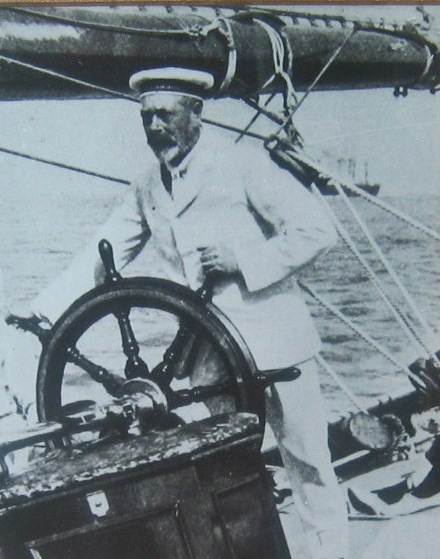
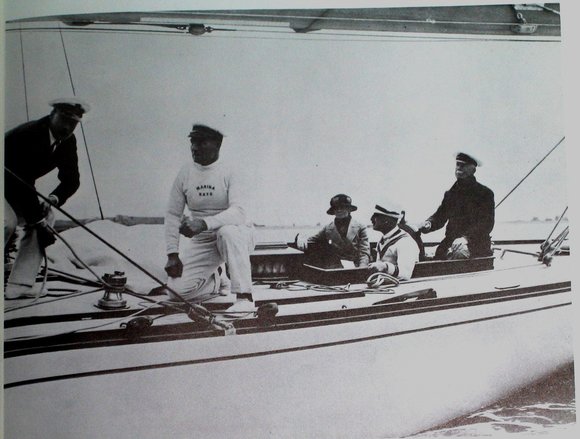
There is no doubt that, had it been not for George V, big yacht racing would have died in the inter-war years. His campaigning of the “Britannia” spurred on the handful of yachtsman with big boats to race, and the Harwich regattas continued to attract this class, albeit in smaller numbers than before. The new J class “Endeavour” underwent race trials at the 1934 Harwich Regatta before coming close to gaining the America’s Cup later that year. During the 1930s most of the British J Class yachts raced at Harwich ably supported in the regattas by the 12 metre fleet headed by Sir William Burton, now Commodore of the RHYC.
By1950 there were sufficient classes racing in Woolverstone to hold the first Woolverstone Regatta. Royal Harwich One Designs, Fireflies, Swordfish and Yachting World cadets formed the classes. This was a new type of racing far more available to ordinary members than the big boat racing of the previous decades. This regatta launched the Club into a period of expansion in the 1950s. King George VI had given his consent to be the Club’s patron, the Nissen huts were extended and modernised, old club paintings were hung once again, archives and book collections formed the basis for a new library, and thus the identity of the Royal Harwich was both preserved and modified at the same time.
Smaller racing yachts also began to make regular appearances at this time. Then the second World War suddenly curtailed all yacht racing for six years. During the war, the Royal Harwich completely closed down. From the latter half of the 19th. century until 1939 the Club had no permanent premises since the old club rooms had been demolished in the expansion of the Navy Yard at Harwich. Various Harwich hotels had been used as RHYC headquarters, in particular the Great Eastern Hotel where all club valuables, archives and papers were stored during the war.
The immediate years after the war were a difficult time for yachting generally. Money to spend on any form of recreation was short, and materials for building yachts virtually unavailable. Fortunately for the Royal Harwich help was at hand from Austin Farrar, yacht and rig designer, and boatyard operator. Having acquired a yard at Woolverstone on the River Orwell between Ipswich and Harwich, he generously offered the RHYC a chance to re-form on part of the land, using wartime Nissen huts as a club house. So, with the first permanent premises since the mid 19th. Century, a hard core of members were able to establish racing from the Club once again. In 1937, a one design fleet of open keel boats designed by Robert Clark and Austin Farrar had been commissioned by the Club. This small fleet of seven boats (soon to be increased to eight) formed the basis for keel boat and dinghy racing from the Club in 1946.
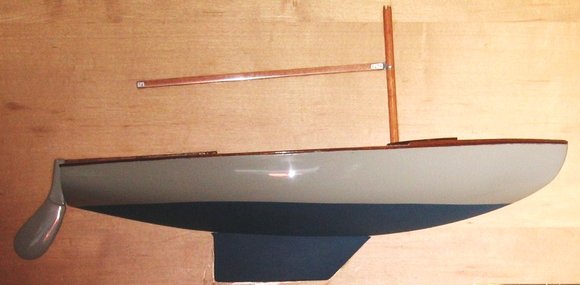
During the 1950s the two established dinghy classes racing from the RHYC were the Swordfish and Firefly classes. Amongst the Swordfish dinghies kept at Woolverstone was one owned by Cambridge University Cruising Club whose members regularly supported the racing from the Club. Dinghy classes tend to ebb and flow in popularity, and apparently nowhere more so than at the Royal Harwich. As the ‘50s slid into the ‘60s and ‘70s the National 12, a development class originally fostered by Sir William Burton, displaced the Firefly and Swordfish fleets together with Enterprises, Wayfarers and Mirrors, particularly popular with an increasingly strong Junior Sailing contingent in the Club. Then in the 1980s Lasers, Toppers and Optimists established themselves on the scene. In the 1980s the RHYC produced national champions in both National 12 and Optimist competition; a healthy result for both adult and junior members.
Alas, on the open keel boat racing front the Royal Harwich One Design fleet of eight boats, although keenly raced, did not attract sufficient support for more boats to be built for the class. This was remedied in 1967 when the Ajax One Design class was introduced the RHYC. This twenty three foot open keel boat was a recent design from the board of Oliver Lee. Being manufactured in GRP it proved a popular boat with club members as it was less expensive to purchase than a new wooden RHOD, and presented a more modern sailing image. As the Ajax fleet steadily grew in strength the RHOD fleet declined, although a handful of dedicated wooden boat enthusiasts in the Club have managed to ensure that the fleet has raced up to the present time without missing a single season. The Ajax fleet is now the single largest fleet of yachts racing from the RHYC today.
Meanwhile larger racing yachts had been gradually making a come-back so that by 1972 it had been possible for the Royal Harwich, and Walton-and-Frinton Yacht Clubs together with the Waldringfield Sailing Club to start offshore racing once again from Harwich Harbour. Initially known as the Medusa Series these successful races became known as the Haven Series. Twenty one years earlier the East Anglian Offshore races had started and proved successful, but catered mainly for yachts racing medium to long distances from port to port, often through the night, whereas the new Haven Series provided offshore day races popular with skippers and owners with less free time on their hands. Also, the start of the Haven Series coincided with a new construction of yachts, no longer in timber, but in GRP and other composite materials, increasing their availability and leading to larger fleets for this popular racing.
But the Royal Harwich had not contained its racing activities to dinghy, keel boat and offshore racing alone. Two members completed solo circumnavigations; James Hatfield in 1987 and Josh Hall in the BOC Global Challenge races of the 1980s and ’90s. Earlier in the Club’s history, club member Alan Villiers with a crew of young people had completed a circumnavigation in the Conrad from 1934 to ’36. It was also Alan Villiers who skippered the Mayflower II from Plymouth to America in 1952.
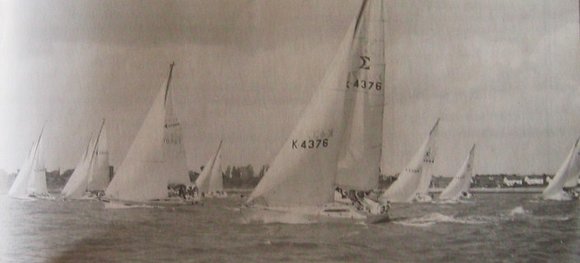
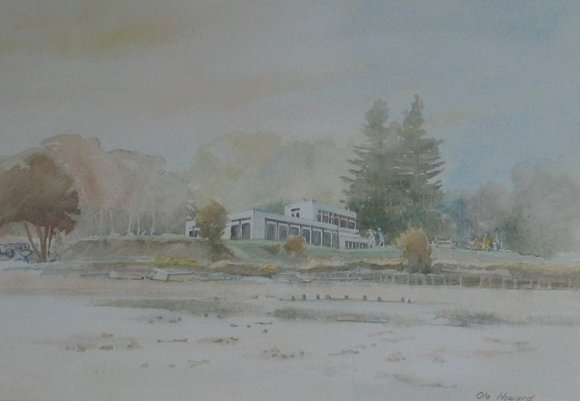
Thus, within only twenty odd years of re-opening after the war, the Royal Harwich was able to its offer members a pretty full variety of yacht racing. With this came the demand for something rather more appropriate as a club house than old wartime Nissen huts. So in 1969 a smart new clubhouse was opened on the Woolverstone site. With various later additions, this structure has lasted to this day providing facilities for members and visiting yachtsmen alike.
With the improved club premises came in 1993 a most important decision for the Club. The construction of a Royal Harwich Yacht Club Marina with floating pontoons stationed at the bottom of the Club Lawn was proposed and accepted by club members after considerable debate. With its own marina together with a number of swinging moorings and laying-up on shore facilities the Club is able to offer to cruising and offshore racing members a complete package of yacht management. This has had a great impact, encouraging a thriving cruising element with club organised cruises in company becoming a popular and vital part of its activities. Now club members cruise way beyond the confines of the East Coast recording passages to all parts of the UK as well as further a field to the Continental Coast, the Baltic, Mediterranean, Black Sea and Caribbean. So once again the Royal Harwich Lion Rampant spans the world’s seas as it had at its outset in the mid 19th. century.
B.A.M
James Ashbury and the Americas Cup
James Ashbury Esq. was probably one of the most colourful characters to be a member of the Royal Harwich Yacht Club throughout its entire history. Elected as a member on May 8th, 1867, he rapidly made his mark and was Commodore by 1870. In that year he raced his Schooner the ‘Cambria’ across the Atlantic from Ireland to New York in challenge against Gordon-Bennett’s Schooner yacht the ‘Dauntless’. Sailing under Royal Harwich colours the ‘Cambria’ arrived first off Sandy Hook light ship; thus winning the race. “A piece of plate” was accordingly given to Ashbury by Gordon- Bennett in the form of a most extravagant silver cup. The main purpose of the Atlantic crossing, however, was to challenge for the America’s Cup, which the ‘Cambria’ did under Royal Thames colours, Ashbury’s other club. The following year, 1871, Ashbury again challenged for the America’s Cup with his new Schooner yacht the ‘Livonia’, this time through the Royal Harwich. He failed in his bid, and as now seems normal for this event, his defeat was accompanied by the usual acrimony as is born out by his persistent correspondence with the New York Yacht Club which was published for the Royal Harwich as “Ashbury’s Reply” in 1872 as well as by Lawson’s History of the America’s Cup written a little later.
Early in 1872, Ashbury resigned as Commodore of the Royal Harwich, not as a result of any ill-feeling over the America’s Cup challenges, but due to his lack of time to reach Harwich regularly and his acceptance of a similar position with the Royal London, a club nearer his home. During his short yet meteoric rise to yachting fame with the Royal Harwich, he generously supported the Club with donations of five fine oil paintings of the ‘Cambria’, ‘Dauntless’ and ‘Livonia’ as well as the Atlantic Trophy which he had won in 1870. Subsequently he kindly agreed to swap the cup for five hundred pounds worth of Mexican Railway Bonds, which the Club converted into shares in a Venezuelan Railway Company in 1880. After various turns of fortune, these shares were eventually sold to enable the Club to re-purchase another trophy, the ‘Amazon’s` Cup in the 1950s. As a gesture of appreciation for his generosity, the Royal Harwich elected Ashbury as an honorary member in 1890.
Although James Ashbury was a man of considerable presence, being impressive both in physique and beard, he was not a fit man. Wealthy as the son of a successful civil engineer, he took up yachting partly to restore his health. He quickly developed an enthusiasm for the sport matched by his pocket, and despite his relatively short active association with the Club, his contribution to the Royal Harwich was considerable. In the 1890s he retired to his Brighton home. In 1895 he moved to London where he died the same year in unfortunate circumstances, not entirely appropriate to his prowess as a yachtsman and gentleman.
HM Cutter Yacht “The Britannia”
The “Britannia” was commissioned by the Prince of Wales, later Edward VII, from the drawing board of G.L.Watson, acknowledged as one of the finest yacht designers of his time. The yacht was launched from the Partick yard on the Clyde in April 1893; With her long out-curving stem, high rig and great sail area she was a radical advance on the clipper bowed low aspect yachts of the 1880s and early ’90s both in looks and performance, winning her first off-shore race in the Thames Estuary from the great yachts “Valkyrie II”, “Calluna” and “Iverna”; By the close of her first season’s racing that year “Britannia” had scored thirty-three wins from forty-three starts; This debut was no fluke, for in her second season she won all seven races for the big class yachts on the French Riviera (the Prince’s favourite sailing area), and then returned to trounce the 1893 America’s Cup winner “Vigilant” in home waters; By the end of her fifth season, not only had her prize money paid for her upkeep, but it also went a long way towards reimbursing the £10,000 which she had cost to build.The 1897 season saw a sad decline in the big class racing, and “Britannia”‘s own racing flag was hauled down and not seen for another fifteen years; During that time she was to change hands six times, twice being re-purchased for the Prince of Wales by royal command, once to act as a trial- horse for Lipton’s America’s Cup challenger “Shamrock I”, and finally after Edward VIII’s coronation to be used as the royal cruising yacht; With raised bulwarks and a reduced rig she was cruised around the coast of Britain by the King and Queen to the popular acclaim of the people, but missing the revival of the big racing class in 1906; Her accommodation was clearly ideal for stately cruising as her general arrangement plans show, the general quality of which we can readily appreciate from her main saloon doors now housed in the Royal Harwich Yacht Club library.
After the death of Edward VII, the “Britannia” officially became the property of King George V, formally Commodore of the Royal Harwich Yacht Club, and then its patron; Two years later in 1913 she was back on the racing scene, entered in the handicap classes with albeit limited success by the King’s representative Major Philip Hunloke whose later association with the yacht was to become legendary. During the years of the first World War the “Britannia” languished unattended in a mud berth, until the King brought her out for racing in 1920; Her return to the regatta circuit was spectacular; Still with her out-dated rig she met the challenge from the fastest modern big yachts including the cutters “Nyria” and “White Heather”, and the American-built schooner “Westward”; George V was so pleased by “Britannia”‘s performance that he ordered a complete refit to put her into competitive racing trim for the 1922 season. This was money well spent, for in 1923 she won twenty-three flags out of twenty-six starts; not bad for a thirty year old yacht; That year also saw the first big class yacht racing with a bermudian rig, but despite altering “Britannia”‘s rig in 1926 and 1927, the King only finally agreed to “go bermudian” in 1931; His stubborn affection for the gaff rig proved to be a correct sentiment, for the “Britannia” fared badly under her bermudian sails despite being handled brilliantly by Sir Philip Hunloke. Strangely enough, it was her windward performance that was lost with the new rig; By 1934 she was hardly competitive with the new highly technical ‘J’ class racers beginning to appear on the scene; Her last race was sailed in 1935 at Cowes.The following year, 1936, King George V died leaving instructions that if none of his sons wanted the yacht, the “Britannia” should be broken up; As this was the case, it was left to Sir Philip to make the arrangements for her last departure; With all her spars, gear and refinements stripped away, her bare hull was towed from the Medina at midnight on July 9th, 1936, out past the Needles light and St. Catherine’s Point to a position somewhere to the south of the Isle of Wight; There she was scuttled and sent to rest beneath the waves; The yard foreman had placed a simple garland of flowers on her stem-head.
No other vessel has ever captured the hearts of the public in quite the same way as the Royal Cutter “Britannia”; A yacht with astounding racing successes as well as exceedingly beautiful lines, she reflected the esteem with which her royal owners were regarded by a nation which has always applauded the spirit of fair competition and corinthianism in all sport and yachting in particular.
The formation of the RHYC and its Royal Patronage
Back in 1821 the proposed launching of the “Essex” Lifeboat at Harwich promoted the idea of a rowing and sailing regatta. However, after two postponements of the launching, the regatta never materialised. This failure was rectified in 1828 when a full scale regatta was held in honour of the Lord High Admiral, the Duke of Clarence, later William IV. The success of this event ensured that regattas at Harwich became an annual fixture. These regattas were organised by a committee, who at dinner after the 1843 Regatta decided to combine with local yachtsmen to form a yacht club. Thus on 28th September, 1843 the bare bones of the Royal Harwich were laid, albeit initially named the Eastern Yacht Club. Despite a successful regatta the following year, no progress had been made to the development of the club. William Knight, a local yachtsman then took charge of a rapid reconstruction, obtaining in 1845 Royal Patronage from the Dowager Queen Adelaide, William IV’s widow as well as an Admiralty Warrant for members to fly the defaced Blue Ensign. A report of the Club’s formation appeared that year in the “Nautical Magazine and Naval Chronicle”, and from that point the Royal Harwich Yacht Club, as it had been named, went from strength to strength.The year 1846 saw patronage granted on behalf of the Monarch Queen Victoria together with her Consort Prince Albert. After Prince Albert’s untimely death, the Queen remained as patron until her death in 1901. During this period the Royal Harwich achieved much, as the earliest Minute Books show, including a challenge for the America’s Cup and the granting of further Admiralty Warrants. Rules and regulations were formulated and adjusted to suit the expansion of the Club with printed sets made available to all members in 1869.
Towards the end of the 19th century Royal patronage was particularly appropriate to the major yacht clubs as the Queen’s son Edward Prince of Wales had joined the yachting scene with the acquisition of the Cutter Yacht Britannia and his election as Commodore of the Royal Yacht Squadron. His son, the Duke of York was also a keen yachtsman, and with his election as Commodore to the Royal Harwich in 1895 started a long and affectionate relationship with the Club. He remained Commodore as Prince of Wales, and in 1910 after his succession granted patronage as King George V. The start of each sailing season saw His Majesty entertained by the members of the Royal Harwich after the “Down Swin” race in a manner befitting a previous Commodore!
Royal patronage lapsed after the death of George V in 1936. Edward VIII had no interest in yachting. The only occasion on which he had been aboard the “Britannia” he spent the entire day driving golf balls off the counter, much to the annoyance of his father. His abdication was followed by wartime, so club matters lay relatively dormant until 1948 when through the enthusiasm of Frank Hussey, club librarian and historian, patronage from King George VI was requested and granted. His Majesty George VI remained patron to the Royal Harwich until his death in 1952.
Accepting condolences from club members at this time, Buckingham Palace advised that HRH Prince Philip, an active dinghy and Dragon class sailor, would be pleased to be asked to accept the post of patron to the Royal Harwich, and it was with great pleasure that his acceptance was received in 1952. Further delight was expressed in 1958 at the visit of HM the Queen and HRH Prince Philip on board the Royal Yacht Britannia to Harwich at which occasion a special edition of Frank Hussey’s “Royal Yachts and Yachting at Harwich” was presented to Prince Philip on behalf of the Royal Harwich.
One hundred and fifty years on from the inauguration of the Club at the 1843 Regatta Dinner, the Royal Harwich Yacht Club is proud and honoured to have His Royal Highness as its patron, and pledges its continued allegiance and loyalty to Her Majesty Queen Elizabeth and HRH Prince Philip.

